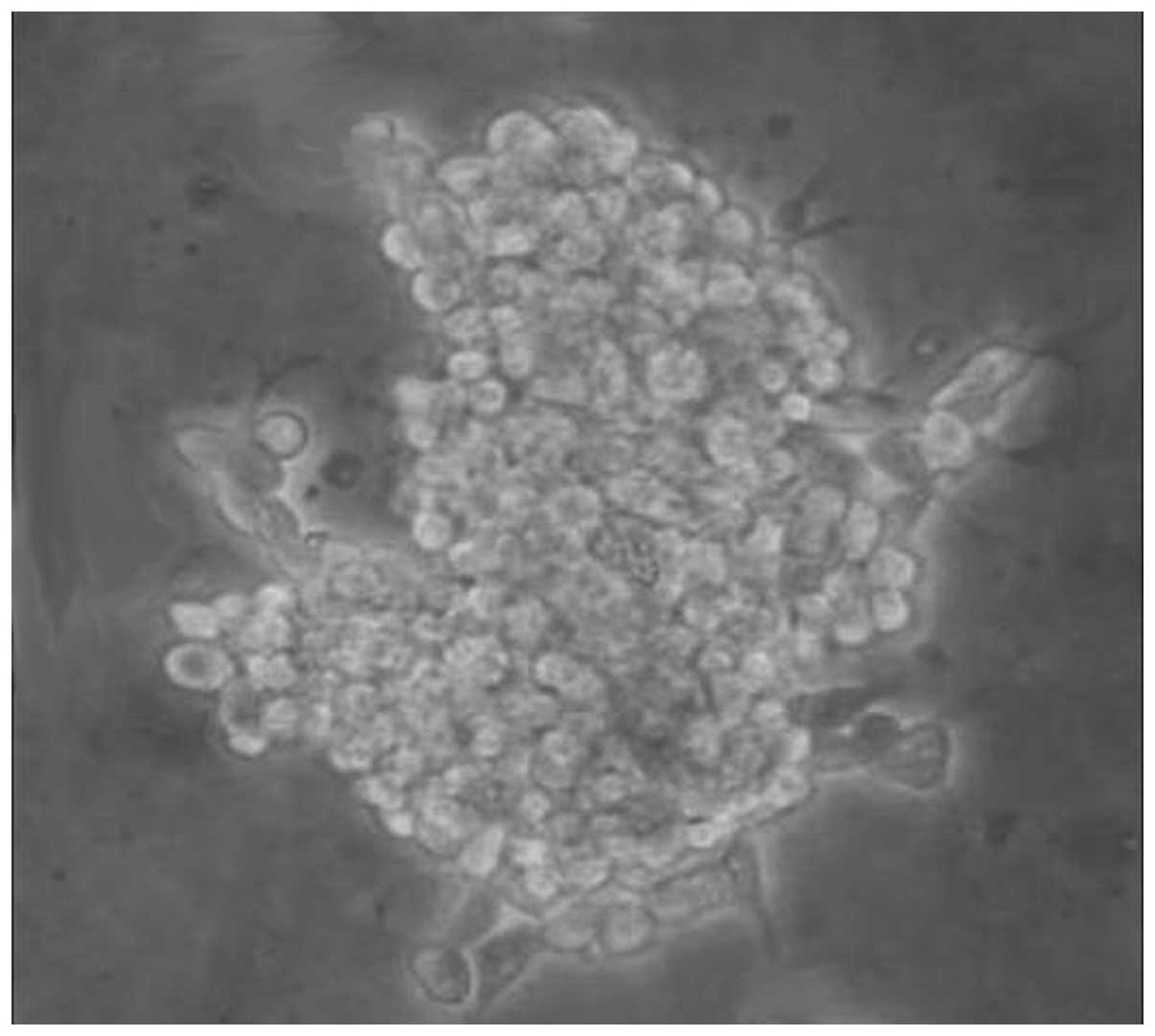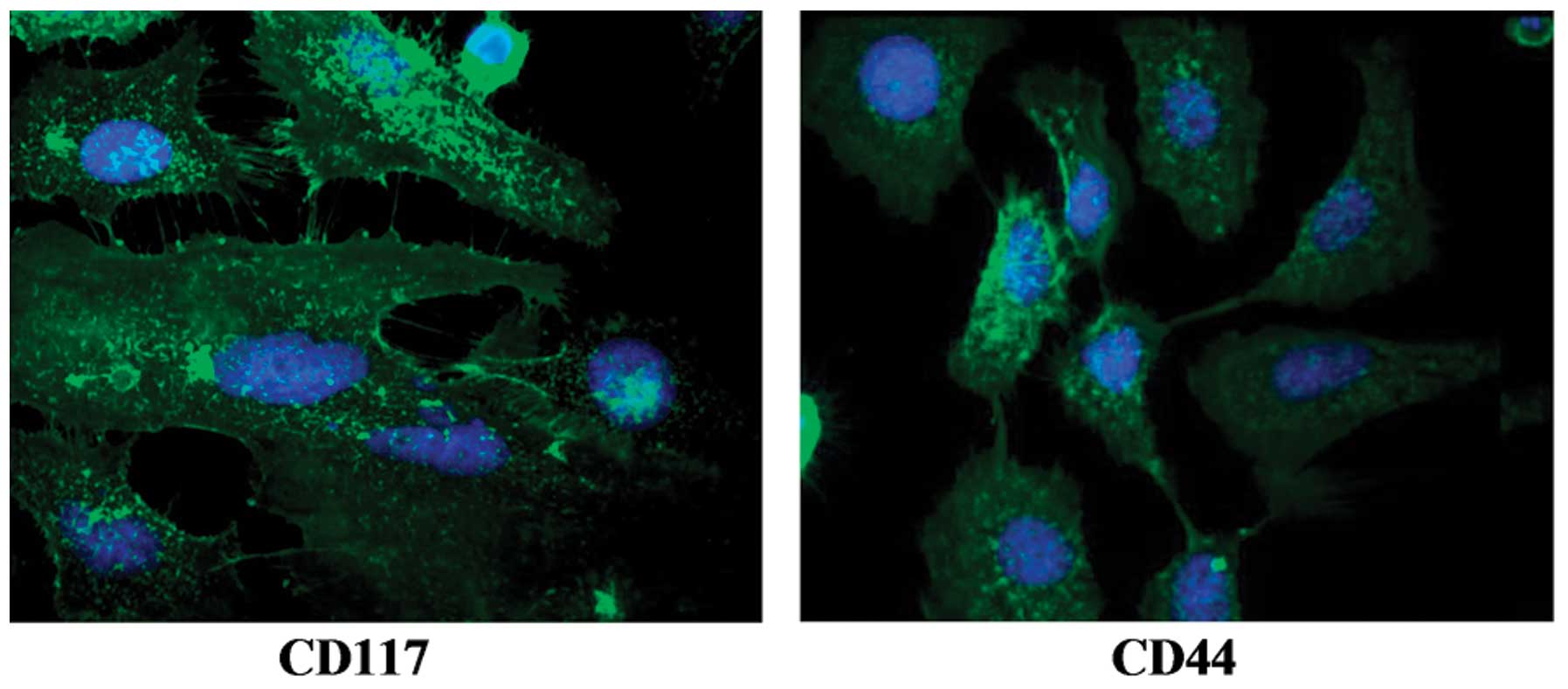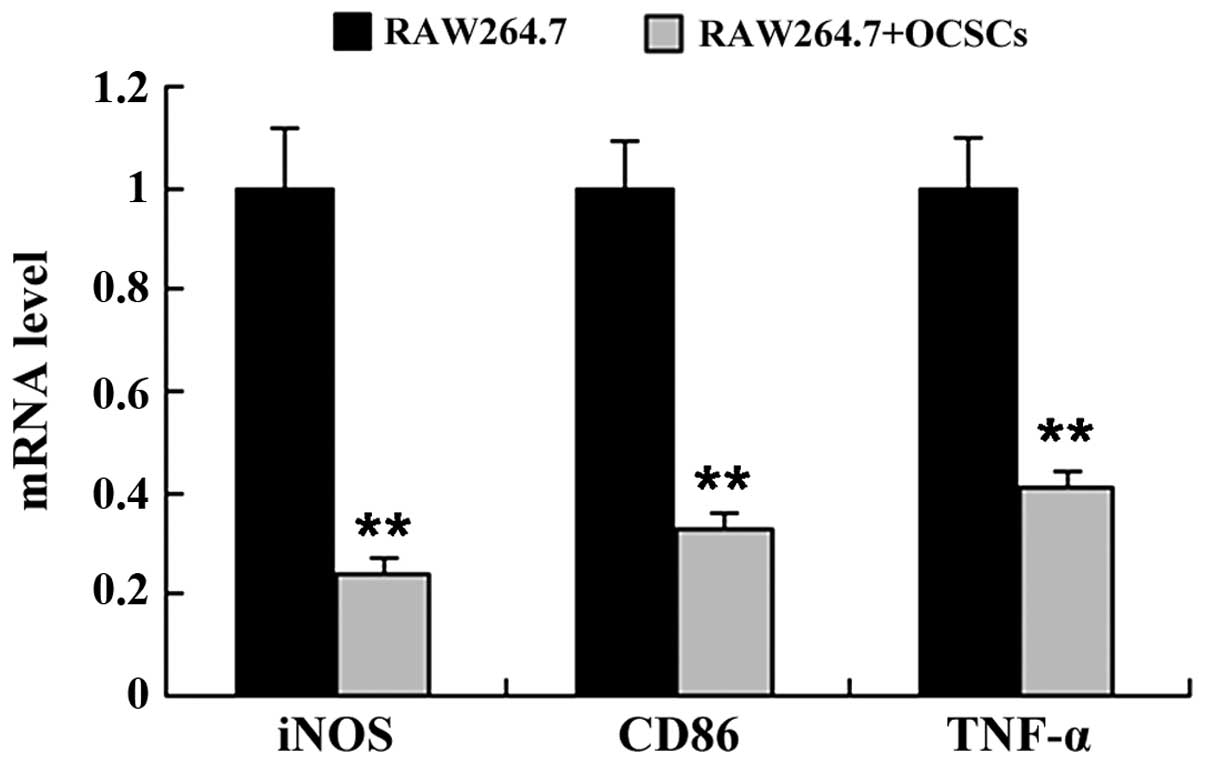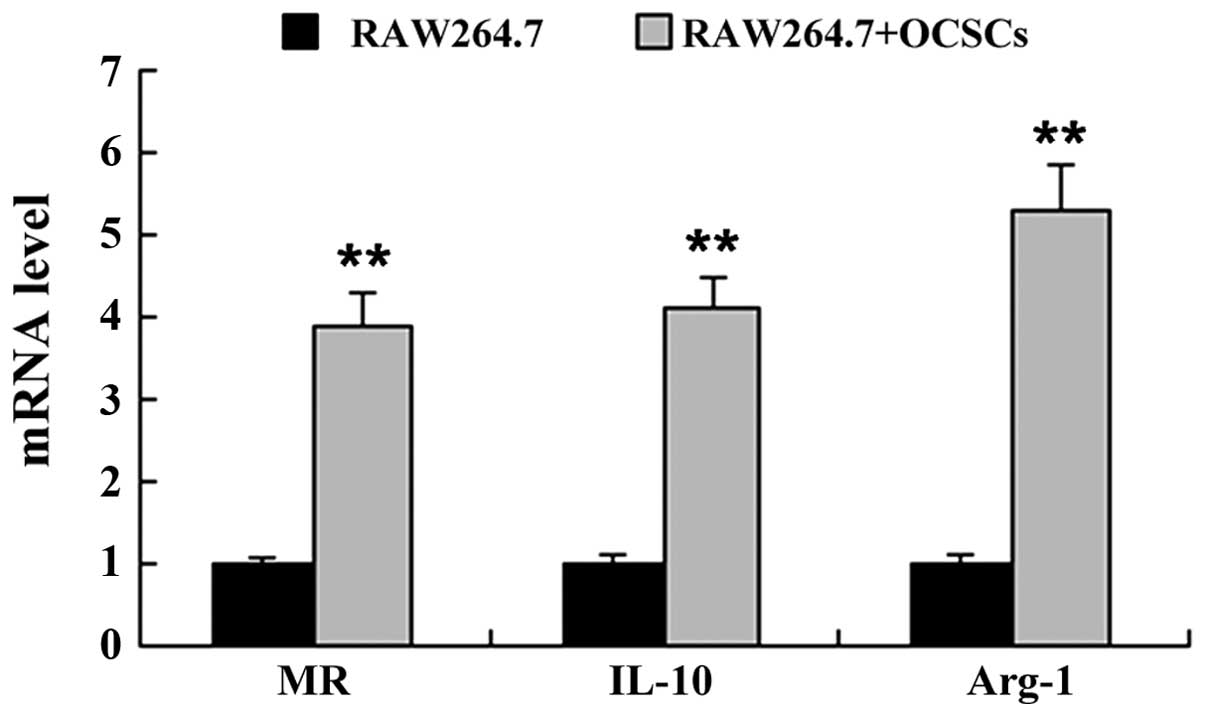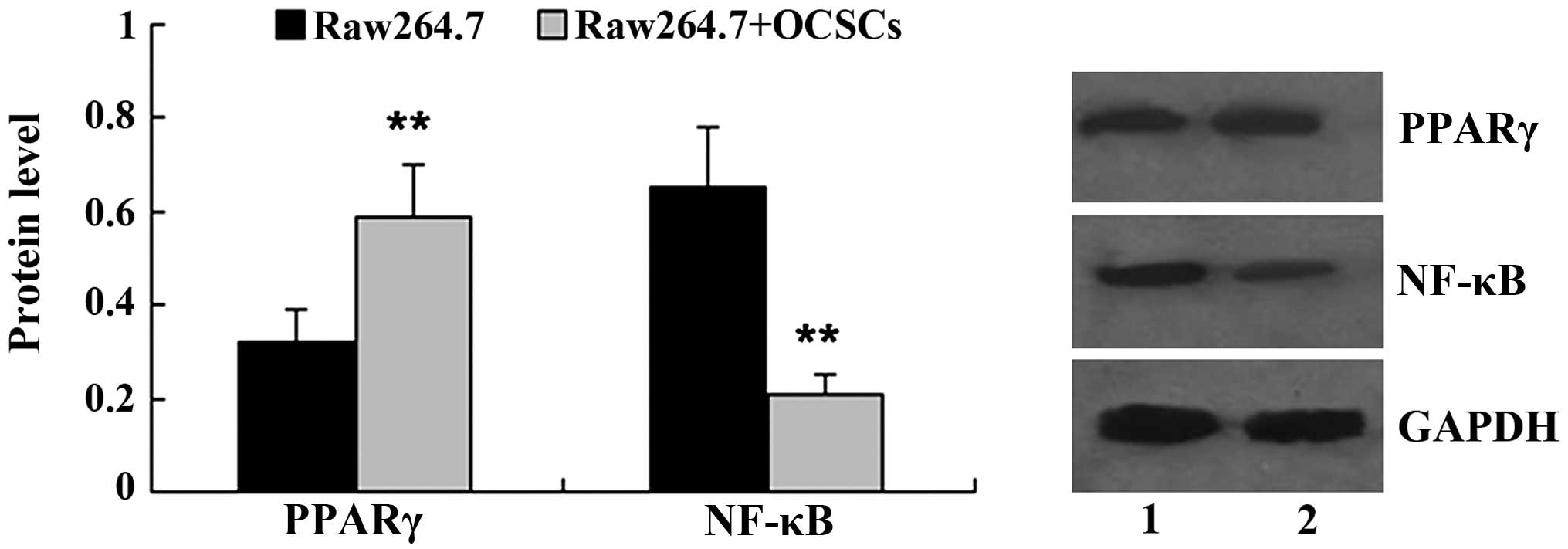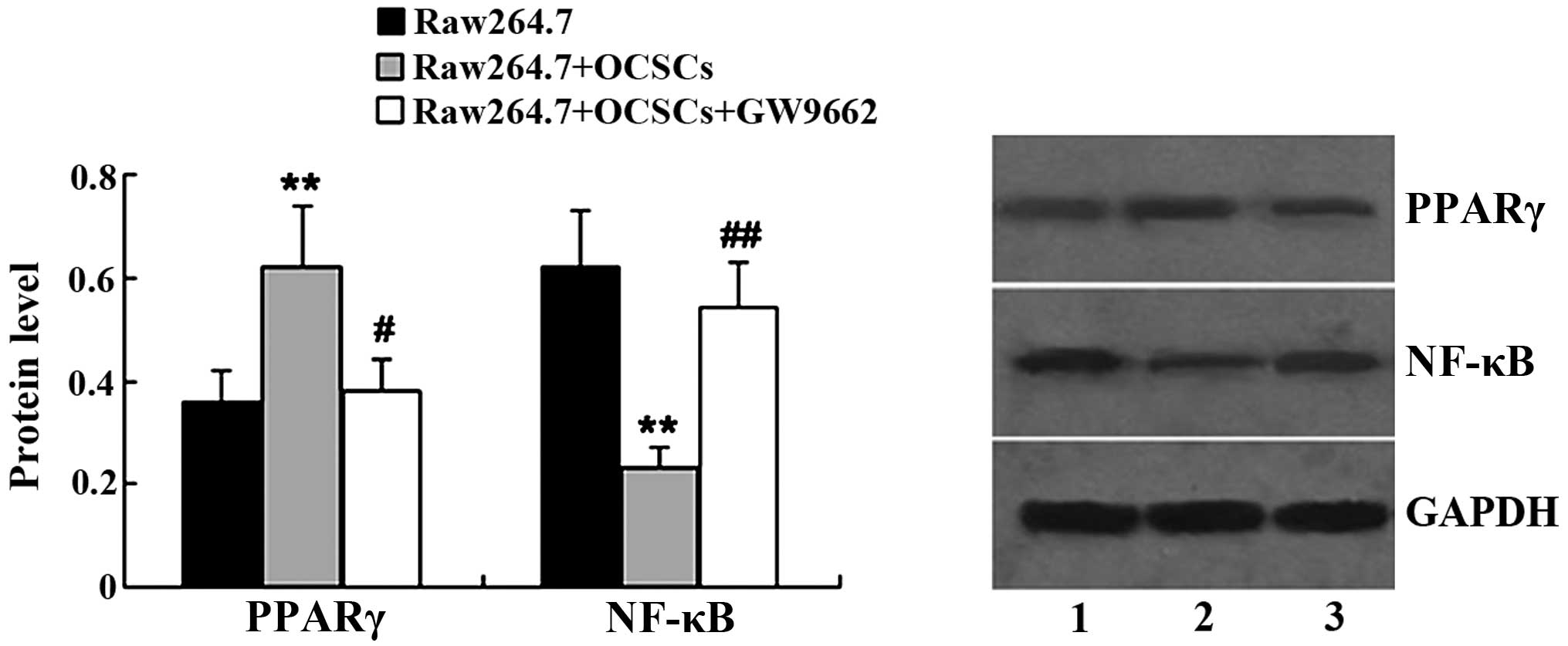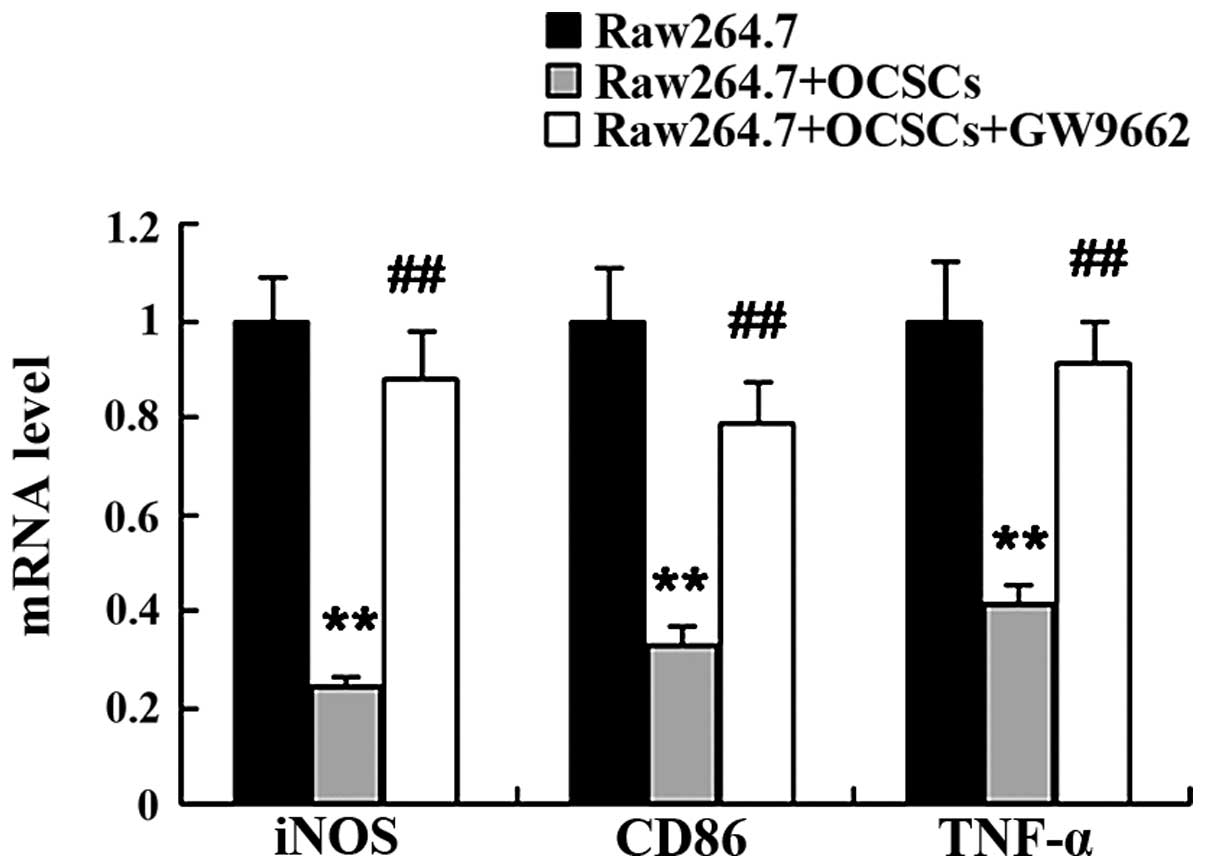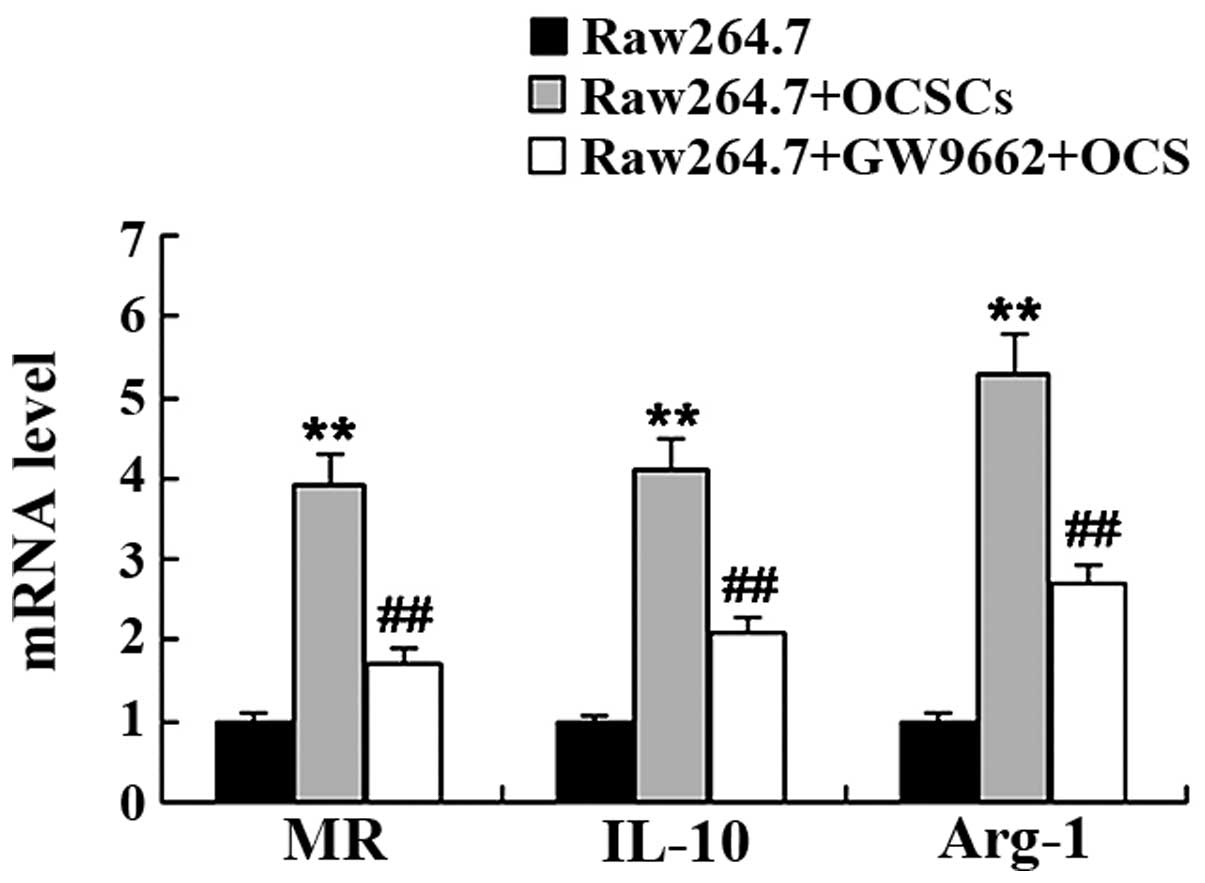Ovarian cancer stem cells induce the M2 polarization of macrophages through the PPARγ and NF-κB pathways
- Authors:
- Published online on: May 29, 2015 https://doi.org/10.3892/ijmm.2015.2230
- Pages: 449-454
Abstract
Introduction
Ovarian cancer is the leading cause of cancer-related mortality among women worldwide and it predominately affects postmenopausal women, with approximately 204,000 women being diagnosed with the disease each year (1). More than 80% of patients with ovarian cancer eventually have a relapse with chemoresistant disease (2,3); therefore, causes a negative impact on the treatment of ovarian cancer.
Cancer stem cells (CSCs) are a small subset of cells capable of initiating and sustaining tumor growth (4). The CSC hypothesis posits that CSCs are a minority population of self-renewing cancer cells that fuel tumor growth and remain in patients after conventional therapy has been completed (5). Therefore, therapies focusing on CSCs seem to be more effective for the treatment of cancer.
Several studies have identified the existence of CSCs in an increasingly longer list of solid tumors (4), including ovarian cancer (6–10). Recurrent ovarian tumors are known to be enriched with CSC-like cells (11). It has been suggested that ovarian CSCs (OCSCs) have the capacity to survive treatment and they may recreate the original patient tumor in animal models (12,13).
A recent study on cancer biology demonstrated that CSCs and the tumor microenvironment seem to be related (14). Tumors can influence the microenvironment by releasing extracellular signals, promoting tumor angiogenesis and inducing peripheral immune tolerance, while immune cells in the microenvironment can affect the growth and evolution of cancer cells, such as in immunoediting (15–17). A recent study revealed that OCSC factors can influence the tumor microenvironment and prognosis (18). The current study was designed to investigate the role of OCSCs in the M1/M2 polarization of macrophages, as well as to elucidate the underlying molecular mechanisms.
Materials and methods
Cell culture
The mouse monocyte macrophage cell line, Raw264.7, was obtained from the American Type Culture Collection (ATCC; Manassas, VA, USA). The cells were cultured in Dulbecco’s modified Eagle’s medium (DMEM; Gibco-BRL, Grand Island, NY, USA) supplemented with 10% fetal bovine serum (Invitrogen Life Technologies, Carlsbad, CA, USA) at 37°C in a humidified atmosphere of 5% CO2. The peroxisome proliferator-activated receptor γ (PPARγ) antagonist, GW9662, was purchased from Cayman Chemical Co. (Ann Arbor, MI, US) and dissolved in 25% DMSO. The Raw264.7 cells were treated with GW9662 at the concentration of 0.1 μM.
Isolation of OCSCs
The mouse ovarian cancer cell line, OVHM, was obtained from the Key Laboratory of Gynecological Oncology, Qilu Hospital of Shandong University, Jinan, China and cultured in DMEM (Gibco-BRL) supplemented with 10% fetal bovine serum (Invitrogen Life Technologies) at 37°C with 5% CO2. A stem-like cell subpopulation from the ovarian cancer cells was obtained and separated through the suspension culture of the OVHM cells in serum-free medium. The OVHM cells were cultured in serum-free DMEM supplemented with epidermal growth factor (20 ng/ml; Invitrogen Life Technologies), basic fibroblast growth factor (20 ng/ml; Invitrogen Life Technologies) and B27 (2%; Gibco-BRL). The cells in suspension formed spheroid structures. The primary spheres were dissociated to generate single cells and serially diluted to plate into 96-well plates at one cell per well. The cells were visualized under a microscope (TS100; Nikon, Tokyo, Japan), and the wells containing one single cell were marked. The secondary spheres were dissociated and plated into serum-free medium at 50 cells/cm2. Sphere-forming cells were passaged up to passage (P)7 and then used for the experiments.
Co-culture of Raw264.7 cells with OCSCs
For co-culture experiments, 0.4-μm pore size Transwell inserts (Corning Inc., Corning, NY, USA) were plated into a 6-well plate. The Raw264.7 cells were seeded at the bottom well, while the OCSCs were seeded onto the inserts.
Reverse transcription-quantitative polymerase chain reaction (RT-qPCR)
Total cellular RNA was extracted from the cells using TRIzol reagent (Invitrogen Life Technologies). The reverse transcription of 1 μg of RNA was performed using a RevertAid™ First Strand cDNA Synthesis kit (Fermentas, Vilnius, Lithuania), following the manufacturer’s instructions. Quantitative PCR (qPCR) was performed using SYBR-Green PCR master mix (Applied Biosystems, Foster City, CA, USA) in a 7900HT fast Real-Time PCR System (Applied Biosystems). The relative levels of gene expression were calculated by the comparative CT method.
Western blot analysis
The specific primary antibodies were rabbit polyclonal to PPARγ (1:800; sc-7196; Santa Cruz Biotechnology, Santa Cruz, CA, USA), rabbit polyclonal to nuclear factor κB (NF-κB; 1:1000; sc-372; Santa Cruz Biotechnology) and rabbit polyclonal to GAPDH (1:2000; ab37168; Abcam, Cambridge, MA, USA). The cells were lysed in ice-cold cell lysis buffer (25 mM Tris-HCl, pH 7.6, 150 mM NaCl, 0.1% Triton X-100, 0.1% Nonidet P-40, 1% sodium deoxycholate, 1% SDS and 2 mM phenylmethylsulfonyl fluoride). Total cellular protein (20 mg) was loaded per lane, separated by 10% SDS-polyacrylamide gel electrophoresis and then transferred onto a polyvinylidene fluoride membrane (Millipore, Billerica, MA, USA) by electroblotting. After blocking with 5% non-fat milk (Inner Mongolia Yili Industrial Group Co., Ltd., Inner Mongolia, China) at 4°C overnight, the membrane was incubated with primary antibodies for 2 h at room temperature followed by incubation with horseradish peroxidase-conjugated anti-rabbit secondary antibody (1:2000; sc-2004; Santa Cruz Biotechnology) for 1 h at room temperature. The signals were probed using an ECL Western Blotting kit (Pierce Biotechnology, Inc., Rockford, IL, USA).
Immunofluorescence staining
CD117 and CD44 are specific markers of OCSCs (6,19). Immunofluorescence staining was used in the present study to detect the expression of CD117 and CD44 in the OCSCs. After washing with PBS, the cells were fixed in 4% paraformaldehyde (Sigma, St. Louis, MO, USA) at 4°C for 1 h. The cells were then permeabilized by exposure to 0.2% TritonX-100 (Sigma) at 4°C for 1 h, followed by blocking with normal goat serum (Maixin, Fuzhou, Fujian, China) at 4°C for a further 1 h. The cells were then incubated with primary antibodies [rabbit polyclonal to CD117 (1:800; ab5506) and rabbit monoclonal to CD44 (1:400; ab51037); Abcam] for 2 h at room temperature. After washing with PBS, [Alexa Fluor 488 labeled Goat anti-rabbit IgG (1:400; ab150077); Abcam] was added and the cells were incubated at 37°C for 1 h. The nucleus was stained with DAPI (Invitrogen Life Technologies) and the slides were visualized under a fluorescence microscope (80i; Nikon).
Statistical analysis
The results were analyzed using SPSS statistical software version 19.0 (SPPS, Inc., Chicago, IL, USA). All the data are presented as the means ± SD. Statistically significant differences between 2 groups were compared using the Student’s t-test, and P-value <0.05 was considered to indicate a statistically significant difference.
Results
Identification of OCSCs
In the present study, a self-renewing, stem-like cell subpopulation from the ovarian cancer cell line, OVHM, was isolated using non-adherent suspension culture. Fig. 1 shows the spheroid structure of the OCSCs in serum-free medium. Immunofluorescence staining was used to confirm the specific markers expressed in the isolated OCSCs. The images from immunofluorescence staining are presented in Fig. 2. The OCSCs showed positively staining for CD117 and CD44.
OCSCs promote the M2 polarization of macrophages
To determine whether OCSCs affect macrophage polarization, the Raw264.7 cells were co-cultured with the OCSCs, and the expression levels of markers of the M1 macrophage phenotype [inducible nitric oxide synthase (iNOS), CD86 and tumor necrosis factor (TNF)-α] and the M2 macrophage phenotype [mannose receptor (MR), interleukin (IL)-10 and arginase-1 (Arg-1)] were measured by RT-qPCR. As shown in Figs. 3 and 4, co-culture of the Raw264.7 cells with OCSCs significantly induced the mRNA expression of markers of the M2 macrophage phenotype, including MR, IL-10 and Arg-1, whereas the mRNA expression of markers of the M1 macrophage phenotype, including iNOS, CD86 and TNF-α was markedly decreased.
OCSCs affects PPARγ/NF-κB expression in Raw264.7 cells
Subsequently, we examined the expression of PPARγ and NF-κB in the Raw264.7 cells co-cultured with OCSCs. Western blot analysis revealed that, in comparison with the Raw264.7 cells cultured alone, co-culture with OCSCs significantly increased the relative protein level of PPARγ, while it decreased the relative protein level of NF-κB (Fig. 5).
GW9662 affects PPARγ/NF-κB expression in Raw264.7 cells
GW9662 was used to treat the Raw264.7 cells co-cultured with OCSCs, and the protein expression levels of PPARγ and NF-κB in the Raw264.7 cells were the measured by western blot analysis. As is shown in Fig. 6, following treatment with GW9662, the expression of PPARγ was significantly decreased in the Raw264.7 cells co-cultured with the OCSCs. In addition, NF-κB expression in the Raw264.7 cells co-cultured with the OCSCs was altered following treatment with GW9662. GW9662 led to an increase in NF-κB expression in the Raw264.7 cells co-cultured with the OCSCs.
Inhibition of PPARγ attenuates the promoting effects of OCSCs on the M2 polarization of macrophages
To examine the role of PPARγ in mediating the promoting effects of OCSCs on the M2 polarization of macrophages, PPARγ was inhibited by treatment with GW9662. We found that the OCSCs promoted the M2 polarization of macrophages with an increased mRNA expression of MR, IL-10 and Arg-1, and a decreased mRNA expression of iNOS, CD86 and TNF-α. However, this effect was reversed by treatment with GW9662. Compared with the Raw264.7 cells co-cultured with the OCSCs, the expression of markers of the M2 macrophage phenotype was significantly decreased, while that of markers of the M1 macrophage phenotype was significantly increased following treatment with GW9662 (Figs. 7 and 8).
Discussion
The tumor microenvironment is a complex cellular environment in which the tumor exists; it consists of cancer cells, fibroblasts, immune cells, surrounding blood vessels, cytokines, chemicals and the extracellular matrix (20–25). The interaction between cancer cells and the tumor microenvironment plays an important role in tumor progression.
Macrophages are a heterogeneous cell population which exists in abundance in the tumor microenvironment, adapting and responding to a large variety of tumor-secreted cytokines (26). Tumor-associated macrophages (TAMs) can influence tumor growth, invasion, angiogenesis and metastasis. There are mainly two types of polarized macrophages, termed M1 and M2 macrophages. Th1 cytokines, such as lipopolysaccharide (LPS), IL-1β and interferon γ (IFNγ promote monocyte differentiation into a ‘classical’ M1 macrophage phenotype, while Th2 cytokines, such as IL-4 and IL-13, lead to an ‘alternative’ M2 macrophage phenotype. M1 macrophages are generally anti-tumoral and they primarily produce pro-inflammatory cytokines, such as TNF-α, IL-6 and IL-12 (27). M2 macrophages on the other hand exert protumoral effects and they produce anti-inflammatory factors, including transforming growth factor (TGF)-β, IL-10 and IL-1 receptor antagonist, as well as promote angiogenesis and tissue remodeling (27–29). Moreover, upon specific signals, macrophages can switch from an activated M1 state back to an M2 state and vice versa (30).
Raw264.7 macrophages have been identified as ‘innate’ macrophages that can differentiate into M1 or M2 macrophages (31). In the present study, we demonstrated the interplay between OCSCs and macrophages. Following co-culture with OCSCs, the macrophages acquired an M2 phenotype characterized by an increased expression of MR, IL-10 and Arg-1, while the expression of M1 macrophages markers, including TNF-α, iNOS and CD86, was suppressed.
NF-κB is one of the major transcription factors responsible for the development of immune responses. NF-κB activation has been associated with the enhanced transcriptional activity of chemokines, cytokines and adhesion molecules, which can facilitate the recruitment and activation of inflammatory cells to the site of NF-κB activation. Gao et al found that mouse mesenchymal stem cells induced macrophage M2 activation through NF-κB (32). As expected, in the present study, the expression of NF-κB in the Raw264.7 cells was inhibited by OCSCs.
PPARγ, a ligand-activated nuclear receptor, is abundantly expressed in macrophages. PPARγ can be activated by natural and synthetic ligands, such as 15d-PGJ2 (33), antidiabetic thiazolidinediones (TZDs) and the GW1929 compound (34). During the differentiation of monocytes into macrophages, the expression of PPARγ is rapidly induced (35). PPARγ modulates the immune inflammatory response with anti-inflammatory properties (36). It has been suggested that PPARγ inhibits the activation of inflammatory response genes (such as IL-2, IL-6, IL-8, TNF-α and metalloproteases) by negatively interfering with NF-κB (37). In the present study, we futher investigated the effects of OCSCs on PPARγ activation in macrophages. The results revealed that the expression of PPARγ was significantly increased in the Raw264.7 cells co-cultured with OCSCs.
To determine whether PPARγ and NF-κB play a role in mediating the effects of OCSCs on the M2 polarization of macrophages, GW9662, a potent and selective antagonist of full-length PPARγ was added to block PPARγ activation. Our results revealed that GW9662 effectively suppressed PPARγ activation in the Raw264.7 cells co-cultured with OCSCs, while the expression of NF-κB increased. Furthermore, treatment with GW9662 influenced M1 and M2 marker expression in the Raw264.7 cells co-cultured with OCSCs. These results support the view that the effects of OCSCs on the M2 polarization of macrophages may be attenuated by treatment with PPARγ inhibitor.
Taken together, the results of the present study suggest a potential functional association between OCSCs and the M1/M1 polarization of macrophages. OCSCs are capable of promoting the M2 polarization of macrophages by affecting the PPARγ/NF-κB pathway.
References
|
Ozols RF, Bookman MA, Connolly DC, Daly MB, Godwin AK, Schilder RJ, Xu X and Hamilton TC: Focus on epithelial ovarian cancer. Cancer Cell. 5:19–24. 2004. View Article : Google Scholar : PubMed/NCBI | |
|
Clarke-Pearson DL: Clinical practice. Screening for ovarian cancer. N Engl J Med. 361:170–177. 2009. View Article : Google Scholar : PubMed/NCBI | |
|
Schwartz PE: Current diagnosis and treatment modalities for ovarian cancer. Cancer Treat Res. 107:99–118. 2002.PubMed/NCBI | |
|
Ailles LE and Weissman IL: Cancer stem cells in solid tumors. Curr Opin Biotechnol. 18:460–466. 2007. View Article : Google Scholar : PubMed/NCBI | |
|
Clarke MF, Dick JE, Dirks PB, Eaves CJ, Jamieson CH, Jones DL, Visvader J, Weissman IL and Wahl GM: Cancer stem cells - perspectives on current status and future directions: AACR Workshop on cancer stem cells. Cancer Res. 66:9339–9344. 2006. View Article : Google Scholar : PubMed/NCBI | |
|
Zhang S, Balch C, Chan MW, Lai HC, Matei D, Schilder JM, Yan PS, Huang TH and Nephew KP: Identification and characterization of ovarian cancer-initiating cells from primary human tumors. Cancer Res. 68:4311–4320. 2008. View Article : Google Scholar : PubMed/NCBI | |
|
Bapat SA, Mali AM, Koppikar CB and Kurrey NK: Stem and progenitor-like cells contribute to the aggressive behavior of human epithelial ovarian cancer. Cancer Res. 65:3025–3029. 2005.PubMed/NCBI | |
|
Burleson KM, Casey RC, Skubitz KM, Pambuccian SE, Oegema TR Jr and Skubitz AP: Ovarian carcinoma ascites spheroids adhere to extracellular matrix components and meso-thelial cell monolayers. Gynecol Oncol. 93:170–181. 2004. View Article : Google Scholar : PubMed/NCBI | |
|
Curley MD, Therrien VA, Cummings CL, et al: CD133 expression defines a tumor initiating cell population in primary human ovarian cancer. Stem Cells. 27:2875–2883. 2009.PubMed/NCBI | |
|
Wani AA, Sharma N, Shouche YS and Bapat SA: Nuclear-mitochondrial genomic profiling reveals a pattern of evolution in epithelial ovarian tumor stem cells. Oncogene. 25:6336–6344. 2006. View Article : Google Scholar : PubMed/NCBI | |
|
Steg AD, Bevis KS, Katre AA, Ziebarth A, Dobbin ZC, Alvarez RD, Zhang K, Conner M and Landen CN: Stem cell pathways contribute to clinical chemoresistance in ovarian cancer. Clin Cancer Res. 18:869–881. 2012. View Article : Google Scholar : | |
|
Alvero AB, O’Malley D, Brown D, Kelly G, Garg M, Chen W, Rutherford T and Mor G: Molecular mechanism of phenoxodiol-induced apoptosis in ovarian carcinoma cells. Cancer. 106:599–608. 2006. View Article : Google Scholar : PubMed/NCBI | |
|
Alvero AB, Fu HH, Holmberg J, Visintin I, Mor L, Marquina CC, Oidtman J, Silasi DA and Mor G: Stem-like ovarian cancer cells can serve as tumor vascular progenitors. Stem Cells. 27:2405–2413. 2009. View Article : Google Scholar : PubMed/NCBI | |
|
Albini A, Cesana E and Noonan DM: Cancer stem cells and the tumor microenvironment: Soloists or choral singers. Curr Pharm Biotechnol. 12:171–181. 2011. View Article : Google Scholar | |
|
Stockmann C, Schadendorf D, Klose R and Helfrich I: The impact of the immune system on tumor: Angiogenesis and vascular remodeling. Front Oncol. 4:692014. View Article : Google Scholar : PubMed/NCBI | |
|
Chouaib S, Kieda C, Benlalam H, Noman MZ, Mami-Chouaib F and Rüegg C: Endothelial cells as key determinants of the tumor microenvironment: Interaction with tumor cells, extracellular matrix and immune killer cells. Crit Rev Immunol. 30:529–545. 2010. View Article : Google Scholar : PubMed/NCBI | |
|
Mantovani A and Sica A: Macrophages, innate immunity and cancer: Balance, tolerance, and diversity. Curr Opin Immunol. 22:231–237. 2010. View Article : Google Scholar : PubMed/NCBI | |
|
Ma W, Ma J, Xu J, Qiao C, Branscum A, Cardenas A, Baron AT, Schwartz P, Maihle NJ and Huang Y: Lin28 regulates BMP4 and functions with Oct4 to affect ovarian tumor microenvironment. Cell Cycle. 12:88–97. 2013. View Article : Google Scholar : | |
|
Alvero AB, Chen R, Fu HH, et al: Molecular phenotyping of human ovarian cancer stem cells unravels the mechanisms for repair and chemoresistance. Cell Cycle. 8:158–166. 2009. View Article : Google Scholar : PubMed/NCBI | |
|
Alvaro T, de la Cruz-Merino L, Henao-Carrasco F, Villar Rodríguez JL, Vicente Baz D, Codes Manuel de Villena M and Provencio M: Tumor microenvironment and immune effects of antineoplastic therapy in lymphoproliferative syndromes. J Biomed Biotechnol. 2010:1–17. 2010. View Article : Google Scholar | |
|
Banchereau J, Briere F, Caux C, Davoust J, Lebecque S, Liu YJ, Pulendran B and Palucka K: Immunobiology of dendritic cells. Annu Rev Immunol. 18:767–811. 2000. View Article : Google Scholar : PubMed/NCBI | |
|
Cretu A and Brooks PC: Impact of the non-cellular tumor micro-environment on metastasis: Potential therapeutic and imaging opportunities. J Cell Physiol. 213:391–402. 2007. View Article : Google Scholar : PubMed/NCBI | |
|
Oluwadara O, Giacomelli L, Brant X, Christensen R, Avezova R, Kossan G and Chiappelli F: The role of the microenvironment in tumor immune surveillance. Bioinformation. 5:285–290. 2010. View Article : Google Scholar : PubMed/NCBI | |
|
Piersma SJ: Immunosuppressive tumor microenvironment in cervical cancer patients. Cancer Microenviron. 4:361–375. 2011. View Article : Google Scholar : PubMed/NCBI | |
|
Sautès-Fridman C, Cherfils-Vicini J, Damotte D, Fisson S, Fridman WH, Cremer I and Dieu-Nosjean MC: Tumor micro-environment is multifaceted. Cancer Metastasis Rev. 30:13–25. 2011. View Article : Google Scholar | |
|
Mantovani A, Schioppa T, Porta C, Allavena P and Sica A: Role of tumor-associated macrophages in tumor progression and invasion. Cancer Metastasis Rev. 25:315–322. 2006. View Article : Google Scholar : PubMed/NCBI | |
|
Gordon S: Alternative activation of macrophages. Nat Rev Immunol. 3:23–35. 2003. View Article : Google Scholar : PubMed/NCBI | |
|
Mantovani A, Locati M, Vecchi A, Sozzani S and Allavena P: Decoy receptors: A strategy to regulate inflammatory cytokines and chemokines. Trends Immunol. 22:328–336. 2001. View Article : Google Scholar : PubMed/NCBI | |
|
Lewis CE and Pollard JW: Distinct role of macrophages in different tumor microenvironments. Cancer Res. 66:605–612. 2006. View Article : Google Scholar : PubMed/NCBI | |
|
Porcheray F, Viaud S, Rimaniol AC, Léone C, Samah B, Dereuddre-Bosquet N, Dormont D and Gras G: Macrophage activation switching: An asset for the resolution of inflammation. Clin Exp Immunol. 142:481–489. 2005.PubMed/NCBI | |
|
Murray PJ and Wynn TA: Protective and pathogenic functions of macrophage subsets. Nat Rev Immunol. 11:723–737. 2011. View Article : Google Scholar : PubMed/NCBI | |
|
Gao S, Mao F, Zhang B, et al: Mouse bone marrow-derived mesenchymal stem cells induce macrophage M2 polarization through the nuclear factor-κB and signal transducer and activator of transcription 3 pathways. Exp Biol Med (Maywood). 239:366–375. 2014. View Article : Google Scholar | |
|
Kliewer SA, Lenhard JM, Willson TM, Patel I, Morris DC and Lehmann JM: A prostaglandin J2 metabolite binds peroxisome proliferator-activated receptor gamma and promotes adipocyte differentiation. Cell. 83:813–819. 1995. View Article : Google Scholar : PubMed/NCBI | |
|
Willson TM, Brown PJ, Sternbach DD and Henke BR: The PPARs: From orphan receptors to drug discovery. J Med Chem. 43:527–550. 2000. View Article : Google Scholar : PubMed/NCBI | |
|
Chinetti G, Griglio S, Antonucci M, Torra IP, Delerive P, Majd Z, Fruchart JC, Chapman J, Najib J and Staels B: Activation of proliferator-activated receptors alpha and gamma induces apoptosis of human monocyte-derived macrophages. J Biol Chem. 273:25573–25580. 1998. View Article : Google Scholar : PubMed/NCBI | |
|
Chinetti G, Fruchart JC and Staels B: Peroxisome proliferator-activated receptors: New targets for the pharmacological modulation of macrophage gene expression and function. Curr Opin Lipidol. 14:459–468. 2003. View Article : Google Scholar : PubMed/NCBI | |
|
Chinetti G, Fruchart JC and Staels B: Peroxisome proliferator-activated receptors (PPARs): Nuclear receptors at the crossroads between lipid metabolism and inflammation. Inflamm Res. 49:497–505. 2000. View Article : Google Scholar : PubMed/NCBI |



